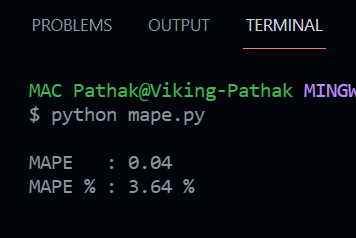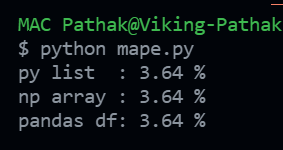如何在Python中计算MAPE
在这篇文章中,我们将看到如何计算确定预测准确性的方法之一,即平均绝对百分比误差(或简称MAPE),也称为平均绝对百分比偏差(MAPD)。绝对百分比误差(或简称MAPE),在python中也被称为平均绝对百分比偏差(MAPD)。MAPE术语决定了我们的预测有多大的准确性。MAPE中的 “M “代表平均数,即一系列的平均值;”A “代表绝对值,即使用绝对值来防止正负误差相互抵消;”P “是百分比,使这个准确性指标成为一个相对指标;”E “代表误差,因为这个指标有助于确定我们预测的误差量。
考虑下面的例子,我们有一个商店的销售信息。日列代表我们所指的日数,实际销售列代表各日的实际销售值,而预测销售列代表销售数字的预测值(可能用ML模型)。APE列代表绝对百分比误差(APE),表示相应一天的实际值和预测值之间的百分比误差。误差百分比的公式是(实际值-预测值)/实际值。APE是这个百分比误差的正(绝对)值。
| Day No. | Actual Sales | Forecast Sales | 绝对百分比误差(APE) |
|---|---|---|---|
| 1 | 136 | 134 | 0.014 |
| 2 | 120 | 124 | 0.033 |
| 3 | 138 | 132 | 0.043 |
| 4 | 155 | 141 | 0.090 |
| 5 | 149 | 149 | 0.0 |
现在,MAPE值可以通过取APE值的平均值来找到。该公式可以表示为 –

让我们看看如何用python对上述数据集进行同样的处理
# Define the dataset as python lists
actual = [136, 120, 138, 155, 149]
forecast = [134, 124, 132, 141, 149]
# Consider a list APE to store the
# APE value for each of the records in dataset
APE = []
# Iterate over the list values
for day in range(5):
# Calculate percentage error
per_err = (actual[day] - forecast[day]) / actual[day]
# Take absolute value of
# the percentage error (APE)
per_err = abs(per_err)
# Append it to the APE list
APE.append(per_err)
# Calculate the MAPE
MAPE = sum(APE)/len(APE)
# Print the MAPE value and percentage
print(f'''
MAPE : { round(MAPE, 2) }
MAPE % : { round(MAPE*100, 2) } %
''')
输出:

MAPE输出是一个非负的浮点数。MAPE的最佳值是0.0,而更高的值则决定了预测不够准确。然而,MAPE值应该有多大,才能称之为低效预测,这取决于用例。在上面的输出中,我们可以看到预测值是足够好的,因为MAPE表明每天的销售预测值有3%的误差。
如果你在python中处理时间序列数据,你可能会使用pandas或NumPy。在这种情况下,你可以使用以下代码来获得MAPE输出。
import pandas as pd
import numpy as np
# Define the function to return the MAPE values
def calculate_mape(actual, predicted) -> float:
# Convert actual and predicted
# to numpy array data type if not already
if not all([isinstance(actual, np.ndarray),
isinstance(predicted, np.ndarray)]):
actual, predicted = np.array(actual),
np.array(predicted)
# Calculate the MAPE value and return
return round(np.mean(np.abs((
actual - predicted) / actual)) * 100, 2)
if __name__ == '__main__':
# CALCULATE MAPE FROM PYTHON LIST
actual = [136, 120, 138, 155, 149]
predicted = [134, 124, 132, 141, 149]
# Get MAPE for python list as parameters
print("py list :",
calculate_mape(actual,
predicted), "%")
# CALCULATE MAPE FROM NUMPY ARRAY
actual = np.array([136, 120, 138, 155, 149])
predicted = np.array([134, 124, 132, 141, 149])
# Get MAPE for python list as parameters
print("np array :",
calculate_mape(actual,
predicted), "%")
# CALCULATE MAPE FROM PANDAS DATAFRAME
# Define the pandas dataframe
sales_df = pd.DataFrame({
"actual" : [136, 120, 138, 155, 149],
"predicted" : [134, 124, 132, 141, 149]
})
# Get MAPE for pandas series as parameters
print("pandas df:",
calculate_mape(sales_df.actual,
sales_df.predicted), "%")
输出:

在上面的程序中,我们描绘了一个单一的函数_calculate_mape() _,它对一个给定的python列表、NumPy数组或pandas序列进行MAPE计算。输出结果是相同的,因为相同的数据被传递给所有3种数据类型格式作为函数的参数。
 极客教程
极客教程